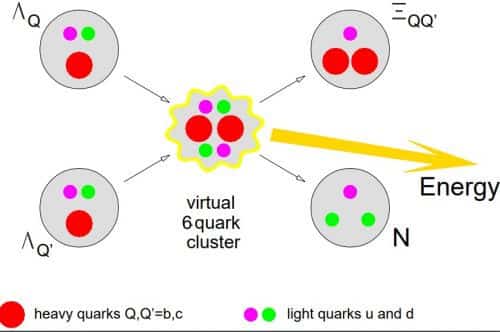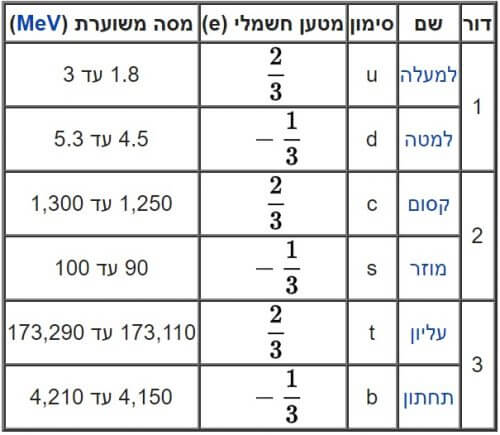The research by Prof. Mark Karliner from the Tel Aviv University and his colleague Jonathan Rosner from the University of Chicago caused echoes in the media. In an interview with the website the scientist Karliner reassures: the quarks in question live a very small fraction of a second and cannot be stored

A theoretical study involving an Israeli researcher managed to arouse echoes in the scientific community after it was published on Thursday in the journal Nature, which also accompanied it with explanatory articles for readers who are not familiar with the ins and outs of physics.
One of the most energetic processes in nature is the process of hydrogen fusion, in which two heavy hydrogen atoms deuterium and tritium form a helium atom while turning the rest of the mass into energy. The process happens naturally in stars such as the Sun, and artificially in hydrogen bombs. Now it turns out, at least theoretically, that there is a much stronger process.
Prof. Mark Karliner from Tel Aviv University and his colleague Prof. Jonathan Rosner from the University of Chicago, both theoretical physicists working at the particle accelerator in Sarn, discovered that a similar process also occurs among particles on a much smaller scale than the atomic nucleus - quarks. As I recall, In July 2017, a particle consisting of two c-type heavy quarks was discovered. Prof. Karliner and Prof. Rosner predicted three years earlier what its mass would be and what its decay rate would be.
Prof. Karliner explains in an interview with the scientist website: "The heavy quarks are created inside the particle accelerator at the axle, as a result of collisions between proton beams moving in the tunnel in opposite directions. This collision causes the release of kinetic energy, some of which becomes a mass of quarks according to Einstein's famous formula E=MC^2. All these quarks arrange themselves in threes and become hadrons in which quarks of different types are mixed, some of them also quarks of type b."
The process involves two baryons, a classification of subatomic particles. Both the protons and neutrons in the atomic nucleus are baryons.
Baryons consist of three quarks. In the case of the proton, these are two quarks of type u (UP) and one quark of type d (Down). In the particle in question - a particle known as lambda C - instead of one of the UP quarks, there is one quark of type c (Charm). There is also a particle with a double charm - one that has two c quarks and one d quark.
Researchers are constantly running experiments at the Large Hadron Collider LHC at the Axis to see what kinds of particles will be produced from smashing proton beams together at the speed of light. Sometimes the energy created in the process causes a different arrangement of the quarks in the particles. The standard model of physics explains how each such particle will behave when it comes into contact with any other particle. When the researchers observed the particle with the double charm, they discovered that a lot of energy was required to connect the two c quarks together - about 130 mega electron volts MeV. Net is released in an energy process with a power of 12 MeV, about two-thirds of the energy released from a parallel process of fusion of hydrogen nuclei. However, when the researchers made a projection on an encounter involving quarks of type b - the heaviest quarks - the numbers are much higher.
Theoretically, in the fusion process two bottom quarks are mixed with 230 MeV, but of these, 138 MeV are released in the form of energy, which could have caused an explosion 8 times stronger than an explosion created by nuclear fusion.
But you can relax - bottom quark particles are also short-lived - a particle of this type survives 100 trillionths of a second (ten to the power of minus 13) and therefore cannot be stored.
"In the process of nuclear fusion, a chain reaction is created - when the initial explosion (made in the process of nuclear fission) ignites the rest of the material inside the bomb. It is impossible to store b quarks and use them at the time of a command... Therefore, even if such a fusion between a pair of b quarks might be possible, they immediately disappear and fade into much lighter quarks, which do not pose a danger." Prof. Karliner explains.


6 תגובות
It seems to me that the terminology in the title should be corrected. Instead of "a process 8 times more powerful than the fusion of hydrogen in an atomic bomb" one should write "a process 8 times more powerful than the fusion of hydrogen in a hydrogen bomb" (or a thermonuclear bomb). The reason: the term "atomic bomb" is used for "nuclear fission bomb". A process opposite to the nuclear fusion process in the hydrogen bomb.
Maybe in the future they will find a stable combination of the quark. A neutron by itself is also unstable (not in the same order of magnitude but still unstable) but in the nucleus of the atom (or in a neutron star) it is stable. Quark storage should not be ruled out in other combinations in the future
The truth is always in the middle...
According to Wikipedia, the lifetime of a b quark is a trillionth of a second.
In the introduction to the article, the decay time of the b quark is not explicitly stated,
It's just great that it's a very short time.
For those interested, entry to the article itself involves a fee of $20.
https://www.nature.com/nature/journal/v551/n7678/full/nature24289.html
Yehuda Sabdarmish
You were right in what you said, but it is not clear which quantitative figure is wrong and which is correct?
Is the correct one: 100 trillion per second?
Or is the correct one: ten to the power of minus 13?
Avi,
Maybe you can attach a link to the original article? Thanks.
A trillion is a millionth. The millionth is 10 to the power of minus 12. A hundred trillion is 10 to the power of minus 10. And not as written in the article.